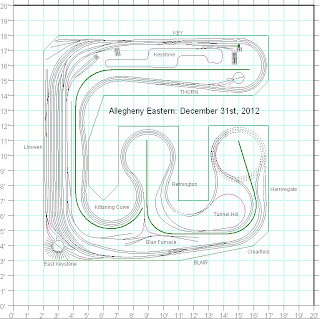The layout occupies a 15' x 15' space in a garage that is roughly 20' square. The track plan is essentially a closed loop consisting of four tracks. The "ruling grade" is the 2% uphill climb between THORN tower and Tunnel Hill. The grade, which represents the east slope of the Allegheny Mountains, is over 30 feet long (over a mile in N scale) with the summit almost 9" above the rest of the layout (about 52" above the garage floor). To return from the top of the grade at Tunnel Hill to Harrowgate I use a four track helix. The helix includes another 30 feet or so of track and also has a 2% grade.
Although the layout depicts the area of Pennsylvania that surrounds PRR's "famous" Horseshoe Curve, railfans and modelers alike will readily notice I have changed all the place names. In my freelanced version I used names that suggested you are in Pennsylvania. Many of them are actually named after places or things in the area being modeled. Some of them are fabricated or borrowed from other places that struck my fancy. The city of Keystone, for instance, is named for the logo of the PRR and Pennsylvania's moniker "the keystone state". Harrowgate is actually a section of Philadelphia know for their string band in the annual Mummers Parade, a long standing tradition in Philly. Remington and THORN were the first things that came to my head.
The Allegheny Eastern also borrows standards and paint schemes from the PRR. Signals along the tracks will be modeled after the Pennsy's white position light type. The locomotives will be painted in the Pennsy's DGLE (Dark Green Locomotive Enamel) sometimes referred to as "brunswick green". The Allegheny Eastern logo is borrowed directly from the Pennsylvania Railroad...
 |
| Allegheny Eastern |
 |
| Pennsylvania Railroad |
The colors and lettering for all cab unit diesels was also borrowed from the PRR, specifically a scheme only used on certain Baldwin "sharknose" units...
Some steam engines also bear this lettering scheme, similar to the way the Pennsy lettered its T1 class of duplex locomotives. Switchers, road switchers and most steam units display only the words ALLEGHENY EASTERN on their hoods or tenders. I also use a classification system for diesels based on the Pennsylvania's system of the late 1940's. In that short period, road locomotives were purchased in sets and the Pennsy classed them that way. A three unit set of Alco PA's, for instance, was designated as AP3. The A designates the builder American Locomotive Company. The P signifies the locomotive is assigned to passenger service. The 3 is the number of units. There was sort of a rhyme and reason to this scheme. All passenger trains were thought to require 6000 HP on the front end. The prime mover in an Alco PA produces 2000 HP. Since the units were to run as a single A-B-A consist the total output of the three units met this requirement. Freight locomotives were classified in a similar way. Switchers and road switchers were always classed as single units.
So much for the various and sundry fundamentals. In upcoming posts, I'll get into the actual construction of the layout itself.
Regards,
Frank Musick
Chief Cook and Bottle Washer
Allegheny Eastern Railroad




No comments:
Post a Comment